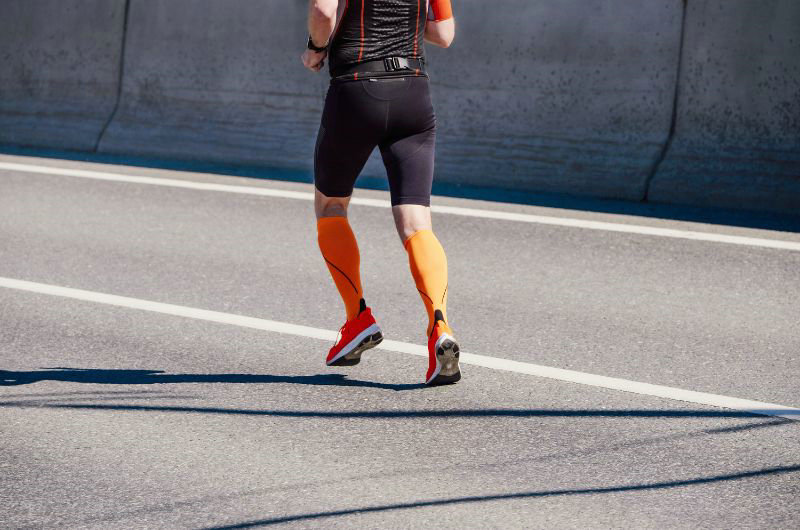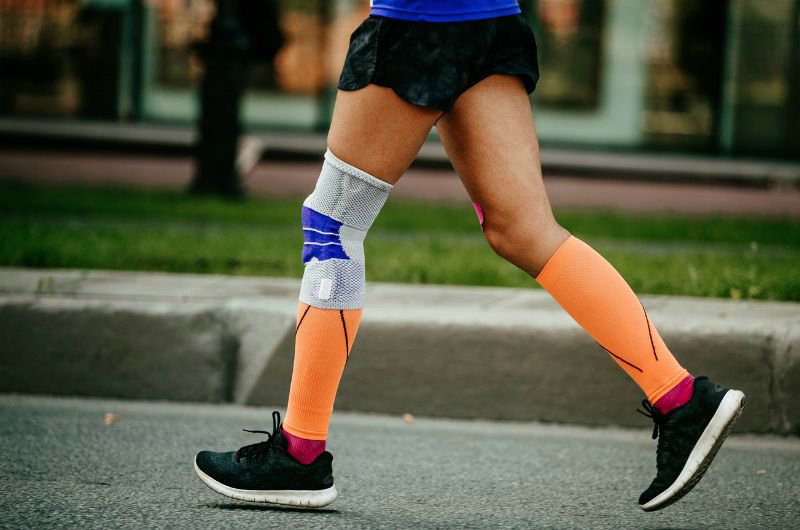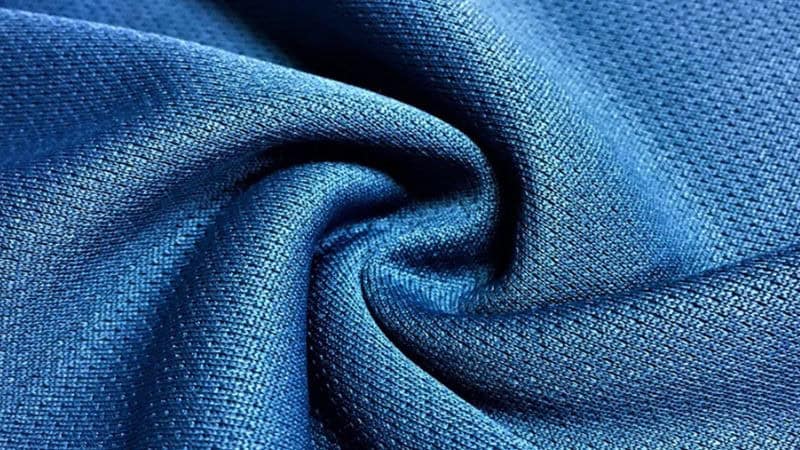
Compression Levels Explained
The right compression level for your stockings can enhance blood flow, ease pain, and prevent several venous disorders. There are 5 main levels of compression for you to choose from. Let’s explore the different levels to determine which is best suited for your needs.
8-15 mmHg (Mild)
This mild compression range is ideal for alleviating discomfort from spider veins or minor swelling. It applies the least pressure, which is great for everyday wear to boost circulation and help tired, aching legs. This mild compression level can also help you in the following aspects:
- Improved Blood Circulation
The gentle squeezing pressure provided by 8-15 mmHg compression socks helps improve venous blood flow from the legs back towards the heart. This prevents blood from pooling in the leg veins, which can lead to swelling, varicose veins, and other circulatory issues. - Relief from Minor Swelling and Edema
The compression helps reduce fluid buildup in the legs and ankles, providing relief from minor swelling and edema. This can be beneficial for people who spend long periods standing or sitting. - Prevention of Deep Vein Thrombosis (DVT)
By improving blood flow, 8-15 mmHg compression socks can help prevent the formation of deep vein blood clots, especially during periods of immobility like long flights or after surgery.
15-20 mmHg (Medium)
- Improved Venous Blood Flow
The graduated compression applies the greatest pressure at the ankles and decreases up the leg. This helps push the venous blood up the legs against gravity, improving circulation from the legs back towards the heart. Better venous return reduces swelling and prevents blood from pooling. - Prevention of Deep Vein Thrombosis (DVT)
By enhancing blood flow in the deep leg veins, 15-20 mmHg compression socks can help prevent the formation of deep vein blood clots, especially during periods of immobility like long flights or after surgery. This reduces the risk of a potentially life-threatening pulmonary embolism. - Relief of Leg Swelling and Edema
The compression helps prevent fluid build-up and pooling in the legs and ankles, alleviating mild to moderate swelling and edema that can occur from sitting or standing for extended periods.
20-30 mmHg (Firm)
- Manage Moderate to Severe Edema/Swelling
The 20-30 mmHg compression level is effective for managing moderate to severe edema or swelling in the legs, ankles, and feet. The graduated compression helps push excess fluid up the leg and back towards the heart, reducing fluid accumulation in the lower extremities. - Treat Varicose Veins and Venous Insufficiency
Firm compression at this level can help relieve symptoms of varicose veins like aching, heaviness, and skin discoloration. It improves venous return and prevents blood from pooling, which can worsen varicose veins and venous insufficiency over time. - Aid Post-Surgical Recovery
20-30 mmHg compression stockings are commonly prescribed after certain surgeries to control post-operative swelling, prevent blood clots, and support healing of the surgical area - Manage Lymphedema
For patients with lymphedema, this level of compression can help reduce swelling and fluid accumulation caused by compromised lymphatic drainage.
30-40 mmHg (Extra Firm)
- Treat Severe Varicose Veins
The firm compression helps alleviate symptoms of severe varicose veins such as aching, heaviness, skin discoloration and inflammation by improving venous return from the legs. - Prevent Deep Vein Thrombosis (DVT)
By enhancing blood flow velocity in the deep leg veins, 30-40 mmHg compression stockings reduce venous stasis and the risk of developing deep vein blood clots, especially for high-risk patients after surgery or with limited mobility. - Manage Post-Thrombotic Syndrome
This compression level is often prescribed to control swelling, pain, and other symptoms caused by post-thrombotic syndrome, which can occur after a DVT episode damages the venous valves. - Aid Venous Ulcer Healing
The improved venous return from the firm compression helps reduce edema and venous hypertension around venous ulcers, creating an environment more conducive to healing. - Post-Sclerotherapy Treatment
30-40 mmHg stockings are commonly worn for several weeks after vein treatment procedures like sclerotherapy to prevent new spider/varicose veins from forming.
40-50 mmHg (Rx)
The highest standard compression, mostly used under medical guidance, is used to manage severe venous disorders and circulation problems. It provides graduated compression from the ankle to the knee or thigh.
- Use case: Recommended for severe cases like advanced chronic venous insufficiency.
- Benefits: Drastically reduces severe edema and venous insufficiency symptoms.
To ensure the most therapeutic benefits and the least risks, select a size based on accurate circumference measurements of your legs and consult with healthcare professionals for precise medical advice before using higher compression levels.
Factors to Consider When Choosing Compression Level

Choosing the right compression level for your socks is critical to ensure they effectively aid your circulation and provide the correct support for your symptoms or activities.
Symptoms and Medical Conditions
1. Mild Symptoms (e.g., tired legs, minor swelling):
– Choose 8-15 mmHg compression for general discomfort, mild swelling, or prevention during travel.
– Ideal for those who stand or sit for long periods.
2. Moderate Symptoms (e.g., varicose veins, moderate swelling):
– Opt for 15-20 mmHg compression to manage moderate swelling, varicose veins, and during pregnancy.
– Suitable for preventing Deep Vein Thrombosis (DVT) during flights.
3. Severe Symptoms (e.g., severe varicose veins, edema, lymphedema):
– Use 20-30 mmHg compression for severe cases of swelling, varicose veins, and post-surgical recovery.
– Recommended for managing symptoms of venous insufficiency and lymphedema.
4. Very Severe Conditions (e.g., venous ulcers, severe chronic venous insufficiency):
– Choose 30-40 mmHg compression for intensive treatment of venous ulcers, severe edema, and post-thrombotic syndrome.
– Often prescribed post-sclerotherapy or for severe lymphedema management.
5. Prescription-Level Needs:
– 40-50 mmHg compression is typically used under strict medical supervision for profound venous diseases and severe lymphatic conditions.
Activity Level and Lifestyle
1. Active Lifestyle:
– Consider lighter compression (8-15 mmHg or 15-20 mmHg) if you are active and need socks for daily wear, sports, or moderate exercise.
– Ensure the socks do not restrict your movement or cause discomfort during activities.
2. Sedentary Lifestyle:
– Medium to firm compression (15-20 mmHg or 20-30 mmHg) can be beneficial if you spend long hours sitting or have limited mobility, to enhance circulation and prevent blood pooling.
3. Frequent Travelers:
– Use 15-20 mmHg compression socks to prevent DVT and swelling during long flights or car rides.
Doctor’s Recommendation
1. Consult Your Doctor:
– Always consult with a healthcare provider to get a prescription and recommendation on the appropriate level of compression based on your medical needs and health status.
2. Proper Fitting:
– Get measured by a professional to ensure the socks fit well. Poorly fitted compression socks can either be ineffective or cause further issues.
3. Follow-Up:
– Regularly review the suitability of your compression socks with your doctor, especially if your medical condition changes or if you experience discomfort.
General Tips
- Graduated Compression: Opt for graduated compression socks, which are tighter at the ankle and gradually decrease in pressure up the leg, to promote optimal blood flow.
- Material and Weave: Choose a material that suits your skin type and climate. Some materials are better for moisture-wicking, while others are warmer.
- Ease of Use: Consider how easy the socks are to put on and take off, especially if you have limited mobility or strength.
Sinoknit’s Compression Sock Offerings

Sinoknit provides a specialized selection of compression socks designed to suit a diversity of needs, ensuring improved blood flow and comfort for users, from athletes to those with medical conditions.
Range of Compression Levels Available
Sinoknit offers compression socks ranging from 15-20 mmHg, known as mild compression, suitable for everyday wear and can be purchased over the counter. The 20-30 mmHg level is a medical class 1 grade, ideal for those experiencing leg swelling or requiring enhanced circulation. For more intensive needs, 30-40 mmHg and 40-50 mmHg options target severe circulatory issues and are typically considered medical-grade compression socks.
- 15-20 mmHg: Over-the-counter, daily wear
- 20-30 mmHg: Medical class 1, moderate swelling and circulation issues
- 30-40 mmHg: Medical class 2, significant circulatory problems
- 40-50 mmHg: Medical class 3, severe conditions
Features and Benefits of Sinoknit Compression Socks
Sinoknit compression socks are imbued with graduated compression technology, ensuring optimal pressure is applied to support blood flow and reduce pain and discomfort. The knee-high and thigh-high options are engineered to prevent bunching and offer sustained recovery support, particularly beneficial for athletes. Each pair incorporates a sizing chart for exact fit, maximizing the therapeutic benefits and circulation improvement.
- Graduated compression: Enhances blood circulation
- Knee-high/Thigh-high options: Prevent bunching; suitable for different needs
- Sizing chart: Ensures precise fit
Materials and Styles Offered
Focusing on your comfort, Sinoknit’s compression socks are made from high-quality, breathable materials, such as nylon and spandex, that fit snugly around your calves and feet without constriction. Style-wise, you can choose from understated designs that seamlessly fit under your shoes to bold patterns that make a statement. For those with peripheral artery disease or deep vein thrombosis, compression sleeves, and high compression-level stockings are also part of the offering.
- Materials: Nylon and spandex for breathability and fit
- Styles: From subtle to bold designs



